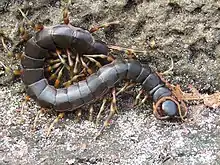Scolopendra galapagoensis
Scolopendra galapagoensis, also known as the Galápagos centipede[3][4] and Darwin's goliath centipede,[5][6] is species of very large centipede in the family Scolopendridae.[7] It is the only representative of the genus Scolopendra on the Galapagos Islands, among twelve other species of centipede present on the Islands.[8][9] It is also found on mainland South America in Ecuador and Peru, and on Cocos Island in Costa Rica.[9][8]
| Scolopendra galapagoensis | |
|---|---|
 | |
| Scientific classification | |
| Domain: | Eukaryota |
| Kingdom: | Animalia |
| Phylum: | Arthropoda |
| Subphylum: | Myriapoda |
| Class: | Chilopoda |
| Order: | Scolopendromorpha |
| Family: | Scolopendridae |
| Genus: | Scolopendra |
| Species: | S. galapagoensis |
| Binomial name | |
| Scolopendra galapagoensis Bollmann, 1889 | |
| Synonyms[1][2] | |
|
Scolopendra gigentea weyrauchi (Bücherl, 1950) | |
Appearance
The Galápagos Centipede is one of the largest species of centipede in the world. Specimens have been recorded with lengths up to 30 cm.[9][6]
Colour morphs
Scolopendra galapagoensis exhibits three colour morphs:[6]
| # | Body | Legs | Notes |
|---|---|---|---|
| 1 | Dark green to black | Striped, Orange to dark brown | This is called the 'Dark Morph' among pet enthusiasts[6]
See speciesbox photo |
| 2 | Orange-red | Pale Yellow | This appears to be called the 'Orange Morph' among pet enthusiasts[6] |
Diet and predation
S. galapagoensis has been reported preying on crickets, newborn rodents, the Galapagos Rice Rat, and, in one paper, a Floreana Racer snake.[6] It is hunted by a variety of birds of prey including the Galapagos hawk, two species of mockingbird, and the common Black Rat.[9]
References
- Léon Baert; Henri W. Herrera. "The Myriapoda of the Galápagos Archipelago, Ecuador (Chilopoda, Diplopoda, Symphyla)". ResearchGate. Belgian Journal of Entomology. Retrieved 14 August 2022.
- Shelley, R. M.; Kiser, S. B. (May 1, 2000). "Neotype designation and a diagnostic account for the centipede, Scolopendra gigantea L. 1758, with an account of S. galapagoensis Bollman 1889 (Chilopoda Scolopendromorpha Scolopendridae)". Tropical Zoology. 13 (1): 159–170. doi:10.1080/03946975.2000.10531129. S2CID 83560131 – via Taylor and Francis+NEJM.
- "Galapagos Species Checklist". Charles Darwin Foundation. Retrieved 2022-08-11.
- "Galápagos Centipede (Scolopendra galapagoensis)". iNaturalist. Retrieved 2022-08-11.
- Dunlap, Sadie (2021-10-11). "The 10 Biggest Centipedes in the World!". AZ Animals. Retrieved 2022-08-11.
- Jake (2022-07-30). "Different Types of Centipedes with Pictures". Pestbugs. Retrieved 2022-08-11.
- "Scolopendra galapagoensis Bollman, 1889". www.gbif.org. Retrieved 2022-08-10.
- Baert, Léon; Herrera, Henri W. (2013). "The Myriapoda of the Galápagos Archipelago, Ecuador (Chilopoda, Diplopoda, Symphyla)". Belgian Journal of Entomology. 1 (49) – via ResearchGate.
- Ortiz-Catedral, Luis; Christian, Eli; Chimborazo, Walter; Sevilla, Christian; Rueda, Danny. "A Galapagos Centipede Scolopendra Galapagoensis Preys On A Floreana Racer Pseudalsophis Biserialis". Galapagos Research. 70: 2, 3 – via ResearchGate, Charles Darwin Foundation.
Further reading & external links
- Neotype designation and a diagnostic account for the centipede, Scolopendra gigantea L. 1758,with an account of S. galapagoensis Bollman 1889
- Scolopendra galapagoensis - Charles Darwin Foundation
- YouTube- Scolopendra galapagoensis (Orange Morph) behaviour in enclosure